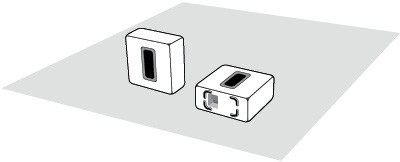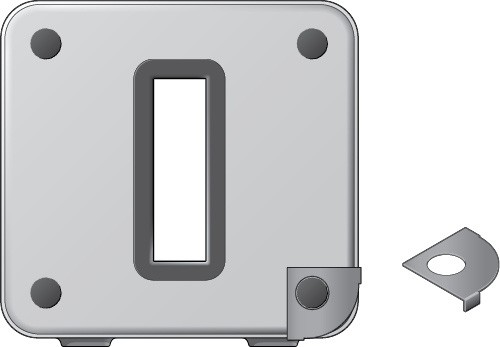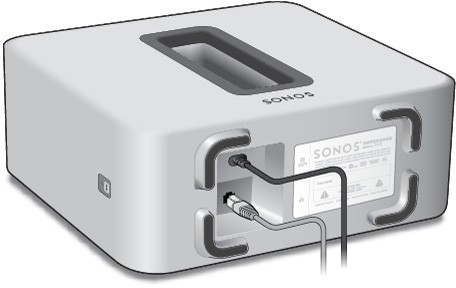
The SONOS SUB takes your music experience to the next level when you add this wireless subwoofer to an existing Sonos room of music.
- Instantly adds a dimension of deep bass impact to your music listening experience.
- Allows placement anywhere because it’s wireless and compact—position it vertically or horizontally on any floor surface.
Note: The SONOS SUB is designed for use with any amplified Sonos player, including the PLAY:3™, PLAY:5™, CONNECT:AMP™ (ZonePlayer 120), or ZP100.
It is not designed for use with unamplified Sonos players, such as the CONNECT™ (ZonePlayer 90) and the ZP80.
New to Sonos?
Set up your Sonos Wireless HiFi System with at least one amplified Sonos player—PLAY:3, PLAY:5, CONNECT:AMP (ZonePlayer 120), or ZP100 before adding the SONOS SUB to your music system. For help with this step, refer to the instructions packaged with your other Sonos components.
Once you’ve set up your music system, you can add additional Sonos components any time (up to 32).
Adding to an Existing Sonos System?
Sonos can be easily expanded room by room. Turn to page 5 for help adding the SONOS SUB to your existing Sonos system.
Sonos Controllers
You can use any Sonos controller with your Sonos system, including:
- The Sonos Controller for Android. Touch the Play Store or Market button on your Android device to download the free Sonos application from Google Play.
- The Sonos Controller for iPhone or the Sonos Controller for iPad. Tap the App Store button on your iPhone, iPod touch or iPad to download the free Sonos application, or you can download the application from iTunes®. (If you download from iTunes, you will need to sync before you see the Sonos logo display on your device.)
- The Sonos Controller for Mac or PC. Download from our Website at:www.sonos.com/install.
- The SONOS CONTROL (CR200) or CR100.
Sonos is always working on new ways to help you control the music any way you want. For the latest list of Sonos controllers, please visit our Web site at
www.sonos.com/products.
Adding the SUB to your Sonos System
You can easily add the SONOS SUB to an existing Sonos system.
- You can associate the SUB with any amplified Sonos player, including a CONNECT:AMP (ZP120), PLAY:3, PLAY:5, or ZP100. You cannot associate it with an un-amplified Sonos player such as the CONNECT (ZP90) or ZP80.
- The SUB is compatible with Sonos software versions 3.8 and later. Be sure to check for software updates before add- ing the SUB to your Sonos system.
1.Carefully unpack the package contents.
Caution: Subwoofers are heavy. Exercise caution when unpacking your SONOS SUB. Use the acoustic slot as a handle to lift the SUB out of the box. (You should always bend your knees when lifting heavy objects to avoid undue stress on your back.)
2.Choose a location for the SUB. It is designed to provide optimal sound wherever you place it.
- You can position the SUB either vertically or horizontally. If you are going to use the SUB horizontally on a smooth floor, you can attach the 4 permanent felt feet (included with your SUB) to each of the corners. See “Attaching the feet for horizontal placement” on page 4 for more information.
 Make sure at least one side of the rectangular opening (acoustic slot) is unobstructed.
Make sure at least one side of the rectangular opening (acoustic slot) is unobstructed.
- If you place the SUB vertically flush against a wall, do not block the front acoustic slot.
- If you place the SUB horizontally on the floor, don’t put anything on top of it. Leave at least 1″ clearance along the top of the SUB if placing under furniture.
- The SUB is designed to be located on the floor. You can place it in a corner, against the wall, behind, under, or next to any piece of furniture on any kind of floor surface.
Note: The SUB contains strong magnets. Don’t place the SUB near equipment that is sensitive to magnetic fields.
3.Attach the power adapter and plug in the SUB.
Be sure to push the power cord firmly into the SUB until it is flush with the surface.

4.Choose one of the following options:
- Using a handheld Sonos controller: Select Add a Sonos Component from the Settings menu.
- Using the Sonos Controller for Mac or PC: Select Add a Sonos component from the Manage menu.

Press and release the
Join button on the side of the SUB.
The indicator flashes green and white while the SUB is connecting
To optimize your SUB’s performance, during the setup process you will be prompted to make some choices—
- If you are joining a CONNECT:AMP or ZP100, select the size of your stereo speakers (Compact, Bookshelf/Ceiling or Floor.)
- Press Play
 to compare the volume of two test sounds, A and B, and then select No Difference, A is louder or B is louder.
to compare the volume of two test sounds, A and B, and then select No Difference, A is louder or B is louder.
- Press Play
 to listen to a test sound, and then select the best level for the SUB. You may be prompted to update the SUB after you add it to your Sonos system.
to listen to a test sound, and then select the best level for the SUB. You may be prompted to update the SUB after you add it to your Sonos system.
Note: After the SUB is associated with a Sonos player, you will not see it displayed separately in the Rooms menu. Any changes you make to that Sonos player (volume, mute, music selection) will also affect the SUB.
Attaching the feet for horizontal placement
If you are going to use your SUB placed horizontally on a smooth floor, the SONOS SUB includes four (4) permanent felt feet you can attach to the corners of the unit. If you are laying the SUB down on a rug or using it vertically, there’s no need to adhere the felt feet.
Note: The felt feet are not adjustable—a strong adhesive will keep them permanently attached to the SUB once you apply them.
The Sonos logo appears on the front of the SUB—you will adhere the felt feet to the opposite side of the unit.
- Lay the SUB down on a rug or on top of the SUB’s felt packing bag so the Sonos logo is facing down and is not visible.
- Place the enclosed guide on one corner of the unit and fold the flaps over the edge.
Felt foot

Guide for felt foot placement
- Peel the backing off one of the feet.
- Press the felt foot (sticky side down) onto the unit inside the circular portion of the guide.
- Repeat this process for the other three (3) corners.
SONOS SUB
Acoustic slot
Status indicator
 Join button
Ethernet port AC Power (Mains)
Join button
Ethernet port AC Power (Mains)
| Join button |
Press the Join button to associate the SUB with your Sonos Wireless HiFi System. |
| Acoustic slot |
The top of the acoustic slot doubles as a handle so you can lift it.
SUB placement: Make sure at least one side of the slot is free from obstruction. If you place it vertically against a wall, do not block the front opening. If you place the SUB horizontally on the floor, don’t put anything on top of it. |
| SUB status indicator |
LED indicates the SUB status.
- See “LED Explanations” for more information.
|
| Ethernet port |
Use an Ethernet cable to connect the SUB to your home network. |
| AC power (mains) input |
Use the supplied power cord to connect to a power outlet. Be sure to use the proper power adapter for your country. Push the power cord firmly into the SUB until it is flush with the surface.
 |
SUB Settings
The SUB’s settings are determined during the initial setup process. If you wish to make changes, follow the steps below to adjust how the SUB works with the associated Sonos component or stereo pair.
Changing SUB Settings
Using a handheld Sonos controller
- Select Settings -> Room Settings.
- Select the room that is associated with the SONOS SUB. It appears as Room (+SUB) on the Room Settings menu.
- Select Advanced Audio -> SUB Settings.
- SUB: Choose On or Off to turn the sound from the SUB on and off.
- SUB Level Adjustment: Use the slider to increase or decrease the volume of the SUB. (You can use this setting to match the subwoofer level to the level of your main speakers.)
- Placement Adjustment (phase): Select On or Off.
- Speaker Size Adjustment (Crossover): This setting only appears when the SUB is associated with a CONNECT:AMP (ZonePlayer 120) or ZonePlayer 100. You may wish to choose a different setting from the list if:
- the main speakers sound distorted at high volumes—moving to a smaller speaker size setting can help.
- your attention is drawn to the SUB’s location while listening to music—moving to a larger speaker size setting can help.
| 1 |
Compact |
110 Hz |
| 2 |
|
100 Hz |
| 3 |
|
90 Hz |
| 4 |
Bookshelf / Ceiling |
80 Hz |
| 5 |
|
70 Hz |
| 6 |
Floor |
60 Hz |
| 7 |
|
50 Hz |
Using the Sonos Controller for Mac or PC
- Select Manage -> Settings (PC) or Sonos -> Preferences (Mac).
- Select Room Settings.
- Select the room that is associated with the SONOS SUB. It appears as Room (+SUB) on the Room Settings menu.
- Select the SUB tab.
- Choose one of the following options:
- SUB: Check to turn the sound from the SUB on; uncheck to turn it off.
- SUB Level Adjustment: Use the slider to increase or decrease the volume of the SUB. (You can use this setting to match the subwoofer level to the level of your main speakers.)
- Placement Adjustment (phase): Check or uncheck the box to adjust the phase.
- Speaker Size Adjustment (Crossover): This setting only appears when the SUB is associated with a CONNECT:AMP (ZonePlayer 120) or ZonePlayer 100. You may wish to choose a different setting from the drop-down list if:
- the main speakers sound distorted at high volumes—moving to a smaller speaker size setting can help.
- your attention is drawn to the SUB’s location while listening to music— moving to a larger speaker size setting can help.
| 1 |
Compact |
110 Hz |
| 2 |
|
100 Hz |
| 3 |
|
90 Hz |
| 4 |
Bookshelf / Ceiling |
80 Hz |
| 5 |
|
70 Hz |
| 6 |
Floor |
60 Hz |
| 7 |
|
50 Hz |
Recalibrating the SUB
After initial setup, you may wish to make some adjustments to optimize your SUB’s performance. If you move the SUB to another location, purchase new speakers, or simply want to adjust the sound, follow the steps below to recalibrate the SUB.
Using a handheld Sonos Controller
- Select Settings -> Room Settings.
- Select the room that is associated with the SONOS SUB. It appears as Room (+SUB) on the Room Settings menu.
Select Advanced Audio -> Recalibrate SUB.
- Follow the prompts to optimize your SUB’s performance:
- Select the size of your stereo speakers (CONNECT:AMP or ZP100 only).
- Press Play
 to compare the volume of two test sounds, A and B, and then select No Difference, A is louder or B is louder.
to compare the volume of two test sounds, A and B, and then select No Difference, A is louder or B is louder.
 Press Play to listen to a test sound, and then select the level you prefer.
Press Play to listen to a test sound, and then select the level you prefer.
Using the Sonos Controller for Mac or PC
- Select Manage -> Settings (PC) or Sonos -> Preferences (Mac).
- Select Room Settings.
- Select the room that is associated with the SONOS SUB. It appears as Room (+SUB) on the Room Settings menu.
- Select the Basic tab, and then select Recalibrate SUB.
- Follow the prompts to optimize your SUB’s performance:
- Select the size of your stereo speakers (CONNECT:AMP or ZP100 only).
- Press Play
 to compare the volume of two test sounds, A and B, and then select No Difference, A is louder or B is louder.
to compare the volume of two test sounds, A and B, and then select No Difference, A is louder or B is louder.
- Press Play
 to listen to a test sound, and then select the level you prefer.
to listen to a test sound, and then select the level you prefer.
Changing the SUB’s Room Association
You can easily associate the SUB with a different Sonos player (CONNECT:AMP, PLAY:3, PLAY:5, or ZP100).
If you are moving the SUB to a new room, first unplug the SUB, locate it on the floor in another room, and then plug it back in. The status light on the side of the SUB will begin to flash. Once it lights solid again, you are ready to proceed.
Using a handheld Sonos Controller
- Select Settings -> Room Settings.
- Select the room that is currently associated with the SONOS SUB. It appears as Room (+SUB) on the Room Settingsmenu.
- Select Remove SUB.
- Choose one of the following settings:
- If you want to associate the SUB with a different Sonos player, select Choose Room for SUB and then select another room.
- If you are not going to use the SUB right now, select Don’t use SUB. It will appear on the Rooms menu as SUB (unused)until you select it and associate it with another Sonos player.
Using the Sonos Controller for Mac or PC
- Select Manage -> Settings (PC) or Sonos -> Preferences (Mac).
- Select Room Settings.
- Select the room that is associated with the SONOS SUB. It appears as Room (+SUB) on the Room Settings menu.
- From the Basic tab, select Remove SUB.
- Choose one of the following settings:
- If you want to associate the SUB with a different Sonos player, select Choose Room for SUB and then select another room.
- If you are not going to use the SUB right now, select Don’t use SUB. It will appear on the Rooms menu as SUB (unused)until you select it and associate it with another Sonos player.
Basic Troubleshooting
Warning: Under no circumstances should the product be repaired by anyone other than an authorized Sonos repair center, as this will invalidate the warranty. Please contact Sonos Customer Support for more information. Do not open the system as there is a risk of electric shock.
If a problem occurs, you can try the troubleshooting suggestions listed below. If one of these doesn’t remedy the problem, or you are not sure how to proceed, please contact the Sonos Customer Support team and we’ll be happy to help.
Web site
SUB not detected during setup
- Did you allow Sonos to check for updates? The SONOS SUB requires software version 3.8 or later.
- Is the power cord properly seated? Be sure to push the power cord firmly into the SUB until it is flush with the surface.
- If either of these is not the problem, a network or a firewall issue may be preventing the SUB from connecting to your Sonos system. Try moving the Sonos components closer together.
LED Explanations
| SUB Status Indicator |
State |
Additional Information |
| Solid white |
Powered up and associated with a Sonos player |
If the associated Sonos player’s white light indicator is turned off, the SUB’s indicator will also be turned off. |
| Solid green |
Muted |
|
| Flashing white |
Powering up (booting) |
|
| Flashing green |
SUB audio is off |
SUB audio has been disabled. See “SUB Settings” on page 6 for more information. |
| Flashing white and green |
Not associated with a Sonos player |
|
| Flashing orange |
Warning mode |
The SUB is beginning to experience a fault condition and will reduce to 75% volume.
- Check the vent slot for adequate cooling
- Check for speaker short circuit
- Check the room temperature to make sure it’s less than 104°F/ 40° C
- If the SUB is in direct sunlight, provide shade Mute and then unmute the Sonos component Unplug the SUB for several minutes to allow it to cool
|
| Flashing orange and then white |
Fault mode |
If the fault condition (above) is not remedied, the Sonos component will automatically mute itself to prevent damage. |
Important Safety Information
- Read these instructions.
- Keep these instructions.
- Heed all warnings.
- Follow all instructions.
- Do not use this apparatus near water.
- Clean only with dry soft cloth. Household cleaners or solvents can damage the finish on your Sonos components.
- Do not install near any heat sources such as radiators, heat registers, stoves, or other apparatus that produce heat.
- Protect the power cable from being walked on or pinched, particularly at plugs, convenience receptacles, and the point where they exit from the apparatus.
- Only use attachments/accessories specified by the manufacturer.
- Unplug this apparatus during lightning storms or when unused for long periods of time.
- Refer all servicing to Sonos qualified service personnel. Servicing is required when the apparatus has been damaged in any way, such as power-supply cable or plug is damaged, liquid has been spilled or objects have fallen into the apparatus, the apparatus has been exposed to rain or moisture, does not operate normally, or has been dropped.
- The Mains plug should be readily available to disconnect the equipment.
- Warning: To reduce the risk of fire or electric shock, do not expose this apparatus to rain or moisture.
- Do not expose apparatus to dripping or splashing and do not place objects filled with liquids, such as vases, on the apparatus.
Caution: Do not sit or stand on the SUB. It could tip over resulting in personal injury.
 The SONOS SUB takes your music experience to the next level when you add this wireless subwoofer to an existing Sonos room of music.
The SONOS SUB takes your music experience to the next level when you add this wireless subwoofer to an existing Sonos room of music.
 Make sure at least one side of the rectangular opening (acoustic slot) is unobstructed.
Make sure at least one side of the rectangular opening (acoustic slot) is unobstructed.
 4.Choose one of the following options:
4.Choose one of the following options:
 Press and release the Join button on the side of the SUB.
The indicator flashes green and white while the SUB is connecting
To optimize your SUB’s performance, during the setup process you will be prompted to make some choices—
Press and release the Join button on the side of the SUB.
The indicator flashes green and white while the SUB is connecting
To optimize your SUB’s performance, during the setup process you will be prompted to make some choices—
 to compare the volume of two test sounds, A and B, and then select No Difference, A is louder or B is louder.
to compare the volume of two test sounds, A and B, and then select No Difference, A is louder or B is louder. to listen to a test sound, and then select the best level for the SUB. You may be prompted to update the SUB after you add it to your Sonos system.
to listen to a test sound, and then select the best level for the SUB. You may be prompted to update the SUB after you add it to your Sonos system. Guide for felt foot placement
Guide for felt foot placement
 Join button
Ethernet port AC Power (Mains)
Join button
Ethernet port AC Power (Mains)

 to compare the volume of two test sounds, A and B, and then select No Difference, A is louder or B is louder.
to compare the volume of two test sounds, A and B, and then select No Difference, A is louder or B is louder. Press Play to listen to a test sound, and then select the level you prefer.
Press Play to listen to a test sound, and then select the level you prefer. to compare the volume of two test sounds, A and B, and then select No Difference, A is louder or B is louder.
to compare the volume of two test sounds, A and B, and then select No Difference, A is louder or B is louder. to listen to a test sound, and then select the level you prefer.
to listen to a test sound, and then select the level you prefer.